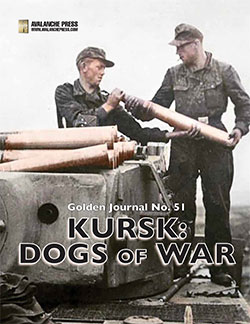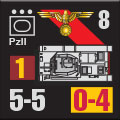| Golden Journal No. 51:
Kursk: Dogs of War
The Panzers
By Mike Bennighof, Ph.D.
March 2023
 We waited a while before adding the Armed SS militia to Panzer Grenadier, but eventually they became difficult to avoid. I assigned them a camouflage color pattern; since they were not part of the German Armed Forces (despite Konrad Adenauer’s “soldiers like any others” white-washing attempt) they needed a separate look. And that’s how they appear in Kursk: South Flank. We waited a while before adding the Armed SS militia to Panzer Grenadier, but eventually they became difficult to avoid. I assigned them a camouflage color pattern; since they were not part of the German Armed Forces (despite Konrad Adenauer’s “soldiers like any others” white-washing attempt) they needed a separate look. And that’s how they appear in Kursk: South Flank.
A “quiet benefactor” funded an alternative set of pieces for South Flank, presenting the Armed SS pieces in the black color scheme we used for in Dishonor Before Death. There are 176 of them, and they appear in Golden Journal No. 51, Kursk: Dogs of War.
The SS militia only started to receive first-line tanks in 1942. The SS Panzer Corps (soon re-named the II SS Panzer Corps) had its first action at Kharkhiv in early 1943, just south of the Kursk salient. Its three divisions had both newer tanks than the Army panzer divisions (other than the similarly-favored Grossdeutschland Division), and more of them. Armed with the newest tanks and plenty of them, the militia failed to deliver its objectives.
Let’s have a look at their machines.
Light Tanks

The Panzerkampfwagen II had been a main battle tank during the invasion of Poland just four years before, but even then its days were numbered as bigger and more powerful machines were in production. With an automatic 20mm gun, it could do some damage to unprotected infantry and thin-skinned vehicles, but it could not survive against enemy armor and even Soviet anti-tank rifles could penetrate its tender hide. A handful of these tanks still served on by the summer of 1943, assigned to divisional reconnaissance battalions for the most part.
Medium Tanks

A handful of Panzerkampfwagen III tanks fought in Poland, but they did not truly make their combat debut until the invasion of France in the spring of 1940. As initially built they carried a 37mm gun, but even as the first models rolled of the production lines German tank designers contemplated upgunning them with a 50mm weapon. That didn’t take place until after the French campaign ended, with the first tanks carrying the 50mm gun entering service in July 1940.
Adolf Hitler personally ordered the tank fitted with a new, longer-barreled 50mm gun (known as the L/60 model) as soon as he saw the initial tanks with the shorter 50mm (the L/42 model). Despite the issuance of the order in August 1940, when Hitler reviewed the troops on his birthday in April 1941 the longer gun still had not been fitted; ordnance tests said the short weapons was perfectly suitable against any enemy armor likely to be encountered. After the Führer raged about his orders being ignored, the manufacturers (seven German firms held assembly contracts) immediately switched to the new weapon.
By the summer of 1943, the PzKpfw III with the long 50mm gun (noted as PzIIIJ in our game, though this represents several models of similar characteristics) still served as the main battle tank of the Waffen SS panzer divisions. Four hundred and thirty-two of the machines, both Army and SS, were listed with the divisions that fought at Kursk. But they had never been a true match for the best Soviet tanks, and they would face hundreds of late-model T-34’s fighting in the Soviet tank corps. Even less capable models with the L/42 gun still served as well; these are designed PzIIIG in the game but likewise represent several models whose differences aren’t enough to show up in the unit ratings.
More Medium Tanks

The Panzerkampfwagen IV initially was designed as an infantry-support tank, with a short-barreled 75mm gun to engage enemy fortifications. These tanks fought in Poland, and in the French campaign were called on to battle the superior French machines that the PzKpfw III could not match. The Germans eventually developed an effective high-explosive antitank round for the short-barreled 75mm gun, but the armored troops really needed a better weapon.
That came in the spring of 1942, when the appearance of the unstoppable Soviet T-34 turned the plans to fit a long-barreled 75mm gun on the tank from “eventual” to “urgent.” The change came in the middle of the production run of the PzKpfw IVF, resulting in some tanks designated F1 (with the short gun) and some known as F2 (with the long one).
The new tank proved extremely effective, giving the German panzer crews a vehicle that could match the Red Army’s tanks and one superior to those the British deployed in North Africa. A year later production shifted to the PzKpfw IVH model, with improved armor protection (and a new transmission to handle the increased weight) and this tank along with the similar model J (both represented by the same piece in Panzer Grenadier games) would serve through the end of the war as the standard tank of the panzer divisions.
At the time of the Kursk offensive, there were still about 60 tanks with the short-barreled 75mm gun serving in the panzer divisions assigned to the attack. In game terms, all of these are designed PzIVE but these pieces also representing the F1 model. Another 841 tanks of the F2 and G models (all covered by the game’s F2 piece) were present at Kursk, and a small number of model H.
Heavy Tanks
 
SS divisions had not yet received the Panzerkampfwagen V Panther tanks at the time of the Kursk attack, but they did wield an equally impressive weapon, the PzKpfw VIE Tiger, later known as the Tiger I. This tank was as large as the big Soviet machines, and carried a much more impressive weapon, the 88mm L/56 gun that could shred any Soviet tank then in service. It had good armor protection, and was only slightly slower than the PzKpfw IV. The SS divisions often had their own organic heavy tank companies; otherwise, this machine served almost exclusively in separate heavy tank battalions.
The SS did not have the Panther, but the 2nd SS Reich Panzer Division made up for this lack by deploying two dozen captured Soviet T-34 tanks. Designated the PzKpfw 747r, these vehicles usually had been modified with a German-style commander’s cupola but retained their Soviet armament — so many Soviet 76.2mm guns had been captured in the early months of the war, that German factories had set up production lines to manufacture ammunition for them.
The best part of the Golden Journal is that it’s free – that’s right, free – to the Gold Club, at least when we first offer it. After that, you have to pay for it.
The Golden Journal is only available to the Gold Club (that’s why we call it the Golden Journal).
Click here to join the Gold Club.
See your Gold Club Insider newsletter for ordering information.
Sign up for our newsletter right here. Your info will never be sold or transferred; we'll just use it to update you on new games and new offers.
Mike Bennighof is president of Avalanche Press and holds a doctorate in history from Emory University. A Fulbright Scholar and NASA Journalist in Space finalist, he has published a great many books, games and articles on historical subjects; people are saying that some of them are actually good.
He lives in Birmingham, Alabama with his wife, three children, and new puppy. He misses his lizard-hunting Iron Dog, Leopold.
Want to keep Daily Content free of third-party ads? You can send us some love (and cash) through this link right here. |
